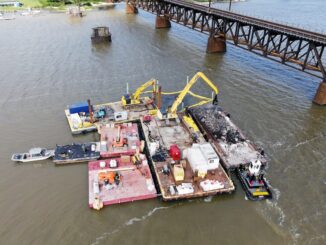WASHINGTON – Government officials say new legislation will expand and improve anti-terrorist security programs for passenger railroad and freight rail systems. The bill was introduced in the U.S. House of Representatives on June 17.
“The Protecting Railroads against Enemy Efforts through Modernization, Planning and Technology Act” (PREEMPT) was introduced by: U.S. Rep. Don Young, R-Alaska, chairman, Transportation & Infrastructure Committee; U.S. Rep. Jack Quinn, R-N.Y., chairman, Subcommittee on Railroads; and U.S. Rep. Jon Porter, R-Nev., vice chairman, Subcommittee on Railroads.
The legislation will provide the resources both to harden our nation’s rail system against the possibility of terrorist attack and to improve our ability to recover from such an incident. It will direct the preparation of comprehensive security plans, including contingency plans, for preventing and, if necessary, recovering from any terrorist incident.
“Much has already been accomplished since the terrorist attacks of Sept. 11, 2001,” Quinn said. “The freight railroads have spent millions of their own dollars to tighten security and protect the nation’s rail system. Similarly, Amtrak and our major commuter rail carriers have implemented a number of new measures to ensure the safety and security of the traveling public.
Provisions of H.R. 4604 range from simple to high-tech, including expanding of the authority of our nation’s existing railroad police force and developing new counter-terror technologies to protect all aspects of the nation’s rail network. The legislation will provide in excess of $1 billion in new money, including more than $600 million to improve the safety of critical rail tunnels used by Amtrak and commuter railroads.
“On May 5th, my Subcommittee held a lengthy hearing on railroad security,” Quinn said. “This hearing was the culmination of an extensive behind-the-scenes effort to improve the security of our nation’s rail system. The Rail Subcommittee Members and staff have been working on this important issue for years, but –given the sensitive nature of the subject matter—most of these discussions have been conducted in private.”
Summary of Major Provisions of PREEMPT Act
- Requires a comprehensive DOT-DHS rail transportation security plan (including contingency plans for keeping the rail network operational after a terrorist incident). Consultation with and input from rail transportation stakeholders is a key element.
- Requires within six months a DOT-DHS memorandum of understanding establishing respective rail security responsibilities.
- Authorizes DOT grants to railroads, shippers, and others for a variety of security-related technologies and improvements, including:
- Automated security inspection [$5 million annually for FY05 and FY06]
- Communication-based train control systems [$20 million]
- Emergency bridge repair and replacement technology [$5 million annually for FY05 through FY08]
- Track, structure and right-of-way integrity monitoring [$3 million for FY05]
- Reduction of tank car vulnerability [$3 million for FY05]
- Bridge and tunnel inspection [$20 million]
- Unified national railroad emergency operations center [$10 million]
- Signal system integrity at switches [$1.5 million annually for FY05 and FY06]
$350 Million in FY05 for:
-
- Security and redundancy for critical communications, electrical power, computer and train control systems
- Rail hazardous material shipment security
- Passenger station, train, and infrastructure security
- Intelligence and information on rail security threats
- Train tracking and interoperable communications technology
- Additional railroad police resources
- Funds DOT procurement of safety/security improvements to Northeast Corridor and Washington DC tunnels:
- $100 million annually for NY tunnels for FY05 through FY08, and $170 million in FY09
- $10 million annually for Baltimore tunnels for FY05 through FY08, and $17 million in FY09
- $8 million annually for Washington DC tunnels for FY05 through FY09
- Expands current authority of railroad police officers to allow exercise of law enforcement powers on any railroad, not just their “home” carrier.
- Requires comprehensive DOT-DHS review of all DOT regulations affecting security within one year.
- Clarifies Federal Railroad Administration authority over rail safety and security matters.
- Applies to all forms of railroad under Federal Railroad Administration jurisdiction, including freight, intercity passenger, commuter, high-speed rail and magnetic levitation systems.




